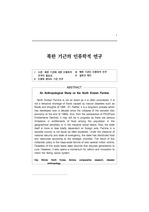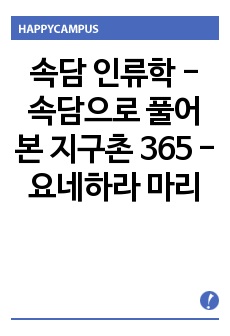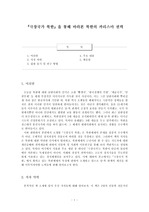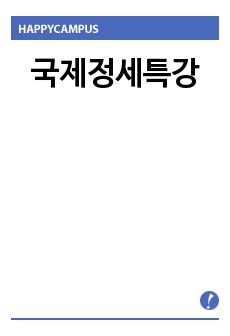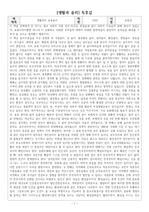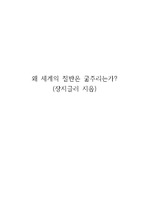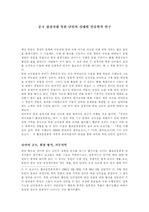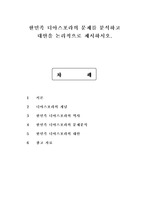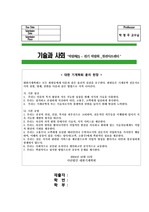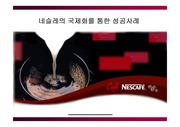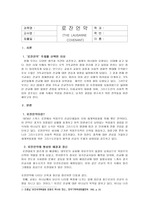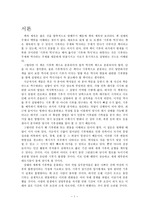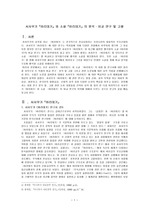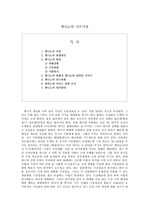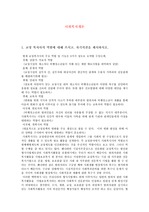

-
미리보기
소개
북한 기근의 인류학적 연구목차
Ⅰ. 서론: 북한 기근에 대한 인류학적
연구의 필요성
Ⅱ. 인류학 분야의 기근 연구
Ⅲ. 북한 기근의 인류학적 연구
Ⅳ. 결론과 제언본문내용
Ⅰ. 서론: 북한 기근에 대한 인류학적 연구의 필요성
북한 기근의 규모와 피해상황에 대해서는 지금도 각자의 입장에 따른 상반되는 의견과 다양한 추측이 엇갈리고 있다. 북한 현지에서 구호활동을 하는 국제기구의 전문가들조차 그 총체적 실상을 이해할 수 없어서 혼란을 겪고 있다. 나초스앤드류 저, 황재옥 옮김, 북한의 기아: 기아와 정치 그리고 외교정책 (서울: 다미디어, 2003), 제1장.
실제로 20세기 전체주의 국가에서 발생하였던 모든 기근은 예외 없이 그 지역을 방문한 외부인에게는 잘 파악되지 않았다. 더욱이 세계에서 가장 폐쇄적인 국가체제를 유지하고 있는 북한의 내부 사정을 현장 접근이 제한된 상황에서 불확실한 통계자료와 전형적인 계량적 방법론으로 이해하기는 불가능한 일이다.
가장 기근이 절박하다고 알려진 시점에도 대외적으로 체제의 굳건한 작동을 보이기 위해 평양에서는 대규모 군사 퍼레이드나 매스게임, 밝게 웃고 뛰노는 아이들의 모습을 보여주기도 해서 더욱 더 상황파악을 어렵게 하였다. 이때 일부 국제기구 관계자들에게 공개한 병실과 고아원에 있는 참혹한 영양실조 상태의 아동들의 모습은 외부의 식량지원을 끌어들이기 위한 선전용이라는 오해를 불러 일으켰다. 이러한 혼란된 이미지 송신은 외부에 대해서만이 아니라 북한 사회 내부에서도 기근의 총체적 진실을 이해하기 어렵게 하였다.참고자료
· <참고문헌>
· 나초스, 앤드류, 황재옥 옮김, 북한의 기아: 기아와 정치 그리고 외교정책, 서울: 다미디어, 2003.
· 박순영, “북한식량위기의 장기적 영향 평가: 인체의 성장발육과 건강에 미치는 영향과 그 사회적 함의,” 한국문화인류학, 2000.
· 박태영, “민간차원의 대북지원에 대한 동기배경활동에 관한 연구,” 사회과학논총, 1999.
· 백승주, “북한 식량위기의 본질과 한국의 대응방향,” 한국민족문화, 1997.
· 서의남, “경계해야 할 북한의 식량 위기전술,” 국방저널, 1996. 6.
· 신의진, “북한의 기아상태가 소아 정신건강에 미친 영향,” 통일연구, 2000.
· 안종철, “북한의 체제유지와 식량문제,” 한국동북아논총, 1996.
· 임원혁, “이디오피아식 대규모 기근에 직면한 북한: 북한 식량난,” 월간조선, 1997년 9월호.
· 정병호, “한민족 통합과정과 북녘돕기운동,” 한겨레 통일문화연구소, 북녘돕기운동의 평가와 전망 국제 심포지움, 1997.
· 정병호, “북한어린이 기아의 장기적 피해와 인류학적 대응방안,” 한국문화인류학, 1999.
· 정병호, “북한 기아 구호활동 민간단체의 현황과 과제,” 임길진장남수 편, 북한의 식량문제: 실태와 대책, 서울: 한울아카데미, 2000.
· 정병호, “분단의 틈새에서: 탈북 난민의 삶과 인권,” 당대비평, 16호, 2001년 가을호.
· 좋은벗들, 두만강을 건너온 사람들, 서울: 정토출판, 1999.
· 좋은벗들, 북한사람들이 말하는 북한이야기, 서울: 정토출판, 2000.
· 좋은벗들, 북한사회, 무엇이 변하고 있는가, 서울: 정토출판, 2001.
· 최태길고재모, “통일이후 한국의 식량수급 전망,” 북한경제연구, 1996.
· 한승훈, “북한의 기근에 관한 연구,” 서강대학교 석사학위 논문, 1999.
· 황장엽, 북한: 진실과 거짓, 통일정책연구소, 1998.
· 황지윤, “북한의 배급체계와 북한이탈주민의 영양상태,” 민족발전연구, 2000.
· Amartya Sen, Poverty and Famines: An Essay on Entitlement and Deprivation, Oxford: Clarendon Press, 1981.
· Becker, Jasper, Hungry Ghosts: Mao`s Secret Famine, New York: Henry Holt and Company, 1998.
· Bennet, J., The Hunger Machine: The Politics of Food, Cambridge: Polity Press, 1987.
· Chung, Byung-Ho, “North Korean Famine and Relief Activities of the South Korean NGOs,” Food Problems in North Korea: Current Situation and Possible Solutions, Seoul: OREUM Publishing House, 2003.
· Chung, Byung-Ho, “Living Dangerously in Two Worlds: The Risks and Tactics of North Korean Refugee Children in China,” Korea Journal, Vol. 43, No. 3, 2003.
· Colin M. Turnbull, The Mountain People, New York: Touchstone Book, 1972.
· Cowte, J. Cruel, Poor, and Brutal Nations: The Assessment of Mental Health in an Australian Aborigine Community by Short-stay Psychiatric Field Team Methods, Honolulu: University Press of Hawaii, 1972.
· Devereux, S., Theories of Famine, Hemel Hempstead: Harvester Wheatsheaf, 1993.
· Dirks, R., “Social Responses during Severe Food Shortages and Famine,” Current Anthropology, Vol. 21, No. 1, 1980.
· EU, UNICEF, WFP, Nutrition Survey of the DPRK, November 1998.
· Evans-Pritchard, E. E., The Nuer, Oxford: Oxford University Press, 1940.
· Friedman, J., “Catastrophe and Continuity in Social Evaluation,” C. Renfrew, M. J. Rowlands, B. A. Segraves, (eds). In Theory and Explanation in Archaeology, New York: Academic Press, 1982.
· Golkin, A. T., Famine: A Beritage of Hunger, Claremont, CA: Regina Books, 1987.
· Jang Soo Hyun, “Living as Illegal Border-Crossers: Social Suffering of the North Korean Refugees in China,” Korea Journal, Vol. 43, No. 3, 2003.
· Kane, P., Famine in China, 195961: Demographic and Social Implications, New York: St. Martin`s Press, 1988.
· Laughlin, Jr., C. D., Brady, I. A. (eds.), Extinction and Survival in Human Populations, New York: Columbia University Press, 1978.
· Oliver-Smith, A., “Anthropological Research on Hazards and Disasters,” Annual Review of Anthropology, Vol. 25, 1996.
· Pak, Sunyoung, “The Growth Status of North Korean Refugee Children in China,” Korea Journal, Vol. 43, No. 3, 2003.
· Pottier, J., Anthropology of Food: The Social Dynamics of Food Security, Cambridge: Polity Press,1999.
· Schneider, D. M., “Typhoons on Yap,” Human Organization, Vol. 16.
· Sen, A., Poverty and Famines: An Essay on Entitlement and Deprivation, Oxford: Clarendon Press, 1981.
· Sen, A., Hunger in the Contemporary World, The Development Economics Research Programme, London School of Economics, 1997.
· Shipton, P., “African Famines and Food Security: Anthropological Perspectives,” Annual Review of Anthropology, Vol. 19, 1990.
· Sorokin, P. A., Man and Society in Calamity, New York: Dutton, 1942.
· Sorokin, P. A., Hunger as a Factor in Human Affairs, Gainsville, Florida: University of Florida Press, 1975.
· Taylor, A. E., Famine, Unpublished manuscript, Stanford Univ., Food Research Institute, 1947.
· Torry, W., “Anthropological Studies in Hazardous Environments: Past Trends and New Horizons,” Current Anthropology, Vol. 20, No. 3, 1979.
· Torry, W., “Drought and the Government-village Emergency Food Distribution System in India,” Human Organization, Vol. 45, No. 1, 1986.
· Torry, W., “Famine Early Warning Systems: The Need for an Anthropological Dimension,” Human Organization, Vol. 47, No. 3, 1988.
· Turnbull, C., The Mountain People, New York: Simon and Schuster, 1972.
· U. S. House of Representatives Committee on Foreign Affairs, Hearings on Tragedy in Indochina: War, Refugees, and Famine, 1979.
· U. S. Senate Committee on Foreign Relations, Hearing on Cambodian Famine and U.S. Contingency Relief Plan, 1979.
· Wanner, Catherine, Burden of Dreams: History and Identity in Post-Soviet Ukraine, Pennsylvania: The Pennsylvania State University Press, 1998.
· Warnock, J. W., The Politics of Hunger, Toronto: Methuen, 1987.
· Yang, D. L., Calamity and Reform in China, Stanford: Stanford University Press, 1996.
· <자 료>
· 우리민족서로돕기 불교운동본부, 북한식량난의 실태, 1998.
· 우리민족서로돕기 불교운동본부, 국경지역난민보고서, 1월~2월, 3월, 1999.
· “북한의 기근 해소를 위한 제언,” 통일경제, 1999. 2.
· 중앙일보, 1997년 4월 19일; 1998년 4월 13일.
· KBS-TV, 2004. 5. 12, “생태도시 시리즈 1: 쿠바-아바나.”
· 가네코 요시노리, 21세기의 모델-쿠바의 유기농업, 사단법인 정농회 옮김, 2001.
· EU, UNICEF, WFP, Nutrition Survey of the DPRK, November, 1998.
· The Economist, “Why is North Korea Starving?,” June 7, 1997.
· Newsweek, “North Korea`s Famine,” May 5, 1997.
· UNICEF, DPRK, An Analysis of the Situation of Children and Woman 2000, December 1999.
· * 투고일 : 2004년 4월 10일 / 심사완료일 : 2004년 5월 14일태그
-
자료후기
Ai 리뷰지식판매자의 이 자료 덕분에 ,복잡했던 과제를 체계적으로 정리하고, 실질적인 결과를 얻을 수 있었습니다. 완벽한 자료였습니다. 매우 추천합니다. -
자주묻는질문의 답변을 확인해 주세요

꼭 알아주세요
-
자료의 정보 및 내용의 진실성에 대하여 해피캠퍼스는 보증하지 않으며, 해당 정보 및 게시물 저작권과 기타 법적 책임은 자료 등록자에게 있습니다.
자료 및 게시물 내용의 불법적 이용, 무단 전재∙배포는 금지되어 있습니다.
저작권침해, 명예훼손 등 분쟁 요소 발견 시 고객센터의 저작권침해 신고센터를 이용해 주시기 바랍니다. -
해피캠퍼스는 구매자와 판매자 모두가 만족하는 서비스가 되도록 노력하고 있으며, 아래의 4가지 자료환불 조건을 꼭 확인해주시기 바랍니다.
파일오류 중복자료 저작권 없음 설명과 실제 내용 불일치 파일의 다운로드가 제대로 되지 않거나 파일형식에 맞는 프로그램으로 정상 작동하지 않는 경우 다른 자료와 70% 이상 내용이 일치하는 경우 (중복임을 확인할 수 있는 근거 필요함) 인터넷의 다른 사이트, 연구기관, 학교, 서적 등의 자료를 도용한 경우 자료의 설명과 실제 자료의 내용이 일치하지 않는 경우
함께 구매한 자료도 확인해 보세요!
-
북한의 의식주 4페이지
남한은 이것을 의식주라고 부른다. 북한이 식의 주라고 부르는 이유는 북한은 옷 입는 것보다는 먹을 게 급해서 이렇게 부른다고 한다. 그나마 약간의 식량을 배급해 주던 북한은 계속되는 식량난으로 공식 배급체계는 거의 완전마비상태에 놓여 있다. 북한의 대부분의 지역에서는 식량배급이 끊어졌거나 중단된 지 이미 오래이며, 원자 재난과 에너지난으로 공식물자 배분체계.. -
세계의 아동복지-일본과 미국 22페이지
Ⅰ. 서론 우리나라의 아동복지정책은 자유방임과 가부장주의 관점에 가장 근접하여 있다. 가족주의를 반영하는 사회복지정책의 실태로서 아동의 부양은 일차적으로 가족책임의 원칙이 지배적이며, 아동수당과 같은 국가에 의한 사회보장체계가 없다는 점을 들 수 있다. 우리나라 사회복지 서비스 정책의 기본방향으로는 가족주의 가치관을 바탕으로 가족-이웃-지역사회-국가로.. -
북한의 식량난 ppt 17페이지
충격! 주민 350만 이상이 굶주림으로 아사했다 ! - 중국으로 간신히 탈출한 난민들의 증언 모두가 굶주림에 시달리며 하루하루를 죽어가고 있음 식량난으로부터 안전한 사람은 소수의 특권층 (간부와 자본가)뿐 350만이상이 영양실조 및 그에 의한 질병으로 사망 - 이는 6.25 전쟁 사망자보다 100만명 많은 수치 -
(아동복지)아동학대의 발생을 감소시키기 위한 개인, 사회, 국가의 역할에 대한 고찰 13페이지
Ⅰ. 서론 - 아동학대에 대한 이론적 고찰 1. 아동학대에 대한 접근 방식에 따른 개념 1) 법적 측면에서의 접근 법적인 측면에서 접근방식은 법규정에 의하여 아동학대의 개념과 가해자의 특정행동 등을 구체적으로 규정하는 조작적인 측면이 강조하는 입장이다. 미국에서는 「아동학대 방지 및 치료법」(Child Abuse Prevention and.. -
[북한 식량난][북한 식량위기][북한 식량난(식량위기) 관련 사례]북한 식량난(식량위기)의 원인과 북한 식량난(식량위기)의.. 9페이지
북한의 식량위기는 과연 얼마나 심각한 것이며 어떻게 진행되어 왔는가? 북한 식량난의 원인은 무엇이며 북한정권은 어떤 자구책을 취해야 하는가? 우리 정부와 국민은 북한주민에 대한 지원책을 어떤 방향으로 설정해야 하는가? 북한의 식량위기에 관한 질문들이 쏟아지고 있지만, 이에 대한 설득력있는 답이 제시되기보다는 전문가들의 북한 식량난 추정 및 정책제언이 엇갈리..
찾으시던 자료가 아닌가요?
지금 보는 자료와 연관되어 있어요!
문서 초안을 생성해주는 EasyAI
